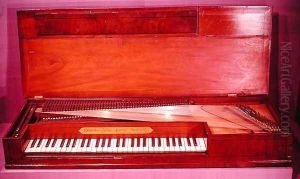Johan Christoph Zumpe Paintings
Johan Christoph Zumpe was born in 1726 in Germany, but he is most notably associated with the development of the piano in England during the 18th century. Moving to England in the mid-18th century, Zumpe initially worked with the renowned harpsichord maker Burkat Shudi. This experience was pivotal, laying the foundation for Zumpe's own contributions to the evolution of keyboard instruments. By the 1760s, Zumpe had established himself as an innovative maker, turning his attention towards the development of the square piano, an instrument that would come to have a significant impact on the musical world.
Zumpe's square pianos, introduced around 1766, were characterized by their compact shape, making them more suitable for domestic use compared to the larger harpsichords and clavichords prevalent at the time. These instruments were noted for their clear tone and responsive action, features that made them highly popular among musicians and amateurs alike. Zumpe's designs incorporated features such as the single action mechanism, which, while simpler than the actions found in later pianos, allowed for expressive playing. This innovation contributed significantly to the piano's evolution into the dominant keyboard instrument of the 19th century.
Johan Christoph Zumpe's work had a considerable influence on the music of his time. His square pianos were among the first to be widely owned and played by the middle class, bringing music into the homes of many who had previously lacked the means to own a keyboard instrument. Notably, Zumpe's pianos were used by composers such as Johann Christian Bach, who appreciated their expressive capabilities. Zumpe's legacy is not just in the instruments he created but also in his contribution to the social expansion of music-making, making the piano accessible to a broader segment of society.
Zumpe's contributions to piano making were recognized in his time, and he became a successful and respected figure in the London musical instrument scene. Despite the competition from other makers and the rapid evolution of piano design, Zumpe's instruments remained popular for several decades. He died in 1790, leaving behind a legacy that significantly influenced the development of the piano. His work paved the way for future innovations and helped to establish the piano as a central instrument in both domestic music-making and public performance.
